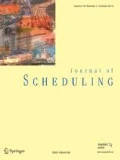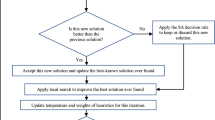Abstract
The schematic representation of schedules has been a useful tool for researchers; in this paper, we review existing network-based schematics for flow shop models. We also propose new schematics for flow shops with blocking, synchronous transfers, no-wait processing, no-idle time and limited buffer space. Using schematics, we explain some of the past findings and present new results. We also explain flow shop anomalies/paradoxes. Finally, we propose schematics for four flow shop models using the concept of string analog.











Similar content being viewed by others
References
Adiri, I., & Poholyres, D. (1982). Flow-shop/no-idle or no-wait scheduling to minimize the sum of completion times. Naval Research Logistics Quarterly, 29, 495–504.
Akers, S. B. (1956). Letter to the editor—A graphical approach to production scheduling problems. Operations Research, 4(2), 244–245.
Bagchi, T., Gupta, J. N. D., & Sriskandarajah, C. (2006). A review of TSP based approaches for flows hop scheduling. European Journal of Operational Research, 169, 816–854.
Bokor, O., Szenik, G., & Kocsis, T. (2011). Application of evaluation lines in the analysis of time-type data of project plans. In C. Egbu & E. C. W. Lou (Eds.), Proceedings of the 27th annual ARCOM conference (pp. 819–827). Bristol: Association of Researchers in Construction Management.
Chang, J. H., & Chiu, H. N. (2005). A comprehensive review of lot streaming. International Journal of Production Research, 43(8), 1515–1536.
Chen, J., & Steiner, G. (1997). Approximation methods for discrete lot streaming in flow shops. Operations Research Letters, 21(3), 139–145.
Cheng, T. E., Gupta, J. N. D., & Wang, G. (2000). A review of flow shop scheduling research with setup times. Production and Operations Management, 9(3), 262–282.
Cheng, M., Mukherjee, N. J., & Sarin, S. C. (2013). A review of lot streaming. International Journal of Production Research, 51(23–24), 7023–7046.
Conway, R., Maxwell, W., McClain, J. O., & Thomas, L. J. (1988). The role of work-in-process inventory in serial production lines. Operations Research, 36(2), 229–241.
Conway, R. W., Maxwell, W. L., & Miller, L. W. (1967). Theory of scheduling. Reading, MA: Addison-Wesley.
Dudek, R. A., Panwalkar, S. S., & Smith, M. L. (1992). The lessons of flow shop scheduling research. Operations Research, 40(1), 7–13.
Eiselt, H. A., & Sandblom, C. L. (2013). Decision analysis, location models, and scheduling problems. Cham: Springer.
Emmons, H., & Vairaktarakis, G. (2012). Flow shop scheduling: theoretical results, algorithms, and applications (Vol. 182). Cham: Springer.
Fernandez-Viagas, V., Ruiz, R., & Framinan, J. M. (2017). A new vision of approximate methods for the permutation flow shop to minimize makespan: State-of-the-art and computational evaluation. European Journal of Operational Research, 257, 707–721.
Fondahl, J. W. (1962). A non-computer approach to the critical path method for the construction industry. Technical Report No. 9, Construction Institute, Department of Civil Engineering, Stanford University, CA.
Gantt, H. L. (1903). A graphical daily balance in manufacture. Transactions of the American Society of Mechanical Engineers, XXIV, 1322–1336.
Garey, M. R., Johnson, D. S., & Sethi, R. (1976). The complexity of flow shop and job shop scheduling. Mathematics of Operations Research, 1(2), 117–129.
Gupta, J. N. D. (1979). A review of flow shop scheduling research. In Larry Ritzman, et al. (Eds.), Disaggregation: Problems in manufacturing and service organizations. Boston, MA: Martinus Nijhoff Publications.
Gupta, J. N. D., & Stafford, E. F., Jr. (2006). Flow shop scheduling research after five decades. European Journal of Operational Research, 169, 375–381.
Hall, N. G., & Sriskandarajah, C. (1996). A survey of machine scheduling problems with blocking and no-wait in process. Operations Research, 44(3), 510–525.
Hejazi, S. R., & Saghafian, S. (2005). Flow shop-scheduling problems with makespan criterion: A review. International Journal of Production Research, 43, 2895–2929.
Herrmann, J. W. (2010). The perspectives of Taylor, Gantt, and Johnson: How to improve production scheduling. International Journal of Operations and Quantitative Management, 16(3), 243–254.
Johnson, S. M. (1954). Optimal two- and three-stage production schedules with setup times included. Naval Research Logistics, 1(1), 61–68.
Kalczynski, P. J., & Kamburowski, J. (2007). On no-wait and no-idle flow shops with makespan criterion. European Journal of Operational Research, 178(3), 677–685.
Kamburowski, J. (2004). More on three-machine no-idle flow shops. Computers & Industrial Engineering, 46(3), 461–466.
Kis, T., & Pesch, E. (2005). A review of exact solution methods for the non-preemptive multiprocessor flow shop problem. European Journal of Operational Research, 164, 592–608.
Kuhpfahl, J. (2016). Job shop scheduling—Formulation and modeling. In J. Kuhpfahl (Ed.), Job shop scheduling with consideration of due dates (pp. 9–23). Wiesbaden: Springer Gabler.
Lee, C. Y., & Chen, Z. L. (2001). Machine scheduling with transportation considerations. Journal of Scheduling, 4(1), 3–24.
Linn, R., & Zhang, W. (1999). Hybrid flow shop scheduling: A survey. Computers & Industrial Engineering, 37, 57–61.
Mascis, A., & Pacciarelli, D. (2000). Machine scheduling via alternative graphs. University of Rome, Rome, Italy, Technical Report DIA-46-2000.
McCormick, S. T., Pinedo, M. L., Shenker, S., & Wolf, B. (1989). Sequencing in an assembly line with blocking to minimize cycle time. Operations Research, 37(6), 925–935.
Minella, G., Ruiz, R., & Ciavotta, M. (2008). A review and evaluation of multi objective algorithms for the flow shop scheduling problem. INFORMS Journal on Computing, 20, 451–471.
Minty, G. J. (1957). Letter to the editor—A comment on the shortest-route problem. Operations Research, 5(5), 724.
Neufeld, J. S., Gupta, J. N. D., & Buscher, U. (2016). A comprehensive review of flow shop group scheduling literature. Computers & Operations Research, 70, 56–74.
Nowicki, E. (1999). The permutation flow shop with buffers: A tabu search approach. European Journal of Operational Research, 116(1), 205–219.
Nowicki, E., & Smutnicki, C. (1996). A fast tabu search algorithm for the permutation flow-shop problem. European Journal of Operational Research, 91(1), 160–175.
Panwalkar, S. S. (1991). Scheduling of a two-machine flow shop with travel time between machines. Journal of the Operational Research Society, 42, 609–613.
Papadimitriou, C. H., & Kanellakis, P. C. (1980). Flow shop scheduling with limited temporary storage. Journal of the ACM, 27(3), 533–549.
Pinedo, M. (2008). Scheduling, theory, algorithms, and systems. New York: Springer.
Reisman, A., Kumar, A., & Motwani, J. (1997). Flow shop scheduling/sequencing research: A statistical review of the literature, 1952–1994. IEEE Transactions on Engineering Management, 44, 316–329.
Rigby, F. D. (1971). Scheduling, sequencing and networks (No. Serial-T-243). George Washington University, Washington DC, Program in logistics.
Rigby, F. D. (1975). Private Communication.
Ruiz, R., & Maroto, C. (2005). A comprehensive review and evaluation of permutation flow shop heuristics. European Journal of Operational Research, 165(2), 479–494.
Ruiz, R., & Vazquez-Rodriguez, J. A. (2010). The hybrid flow shop scheduling problem. European Journal of Operational Research, 205, 1–18.
Smith, M. L., Panwalkar, S. S., & Dudek, R. A. (1975). Flow shop sequencing problem with ordered processing time matrices. Management Science, 21(5), 544–549.
Smith, M. L., Panwalkar, S. S., & Dudek, R. A. (1976). Flow shop sequencing problem with ordered processing time matrices: A general case. Naval Research Logistics, 23(3), 481–486.
Smutnicki, C. (1998). A two-machine permutation flow shop scheduling problem with buffers. Operations-Research-Spektrum, 20(4), 229–235.
Soylu, B., Kirca, Ö., & Azizoğlu, M. (2007). Flow shop-sequencing problem with synchronous transfers and makespan minimization. International Journal of Production Research, 45(15), 3311–3331.
Spencer, D. L. (1969). An investigation of the relationships between the sequencing and scheduling problems. Doctoral dissertation, Texas Tech University.
Spieksma, F. C., & Woeginger, G. J. (2005). The no-wait flow-shop paradox. Operations Research Letters, 33(6), 603–608.
Stern, H. I., & Vitner, G. (1990). Scheduling parts in a combined production-transportation work cell. Journal of the Operational Research Society, 41, 625–632.
Waldherr, S., & Knust, S. (2015). Complexity results for flow shop problems with synchronous movement. European Journal of Operational Research, 242(1), 34–44.
Weaver, P. (2006). A brief history of scheduling: Back to the future. In Proceedings of the 2006 myPrimavera06 conference, Canberra.
Wilson, J. M. (2003). Gantt charts: A centenary appreciation. European Journal of Operational Research, 149(2), 430–437.
Yenisey, M. M., & Yagmahan, B. (2014). Multi-objective permutation flow shop scheduling problem: Literature review, classification and current trends. Omega, 45, 119–135.
Ying, K. C., & Liao, C. J. (2004). An ant colony system for permutation flow-shop sequencing. Computers & Operations Research, 31(5), 791–801.
Acknowledgements
We would like to thank the Associate Editor and the referees for their valuable comments; these comments helped us improve an earlier version of this paper.
Author information
Authors and Affiliations
Corresponding author
Rights and permissions
About this article
Cite this article
Panwalkar, S.S., Koulamas, C. The evolution of schematic representations of flow shop scheduling problems. J Sched 22, 379–391 (2019). https://doi.org/10.1007/s10951-018-0594-9
Published:
Issue Date:
DOI: https://doi.org/10.1007/s10951-018-0594-9




